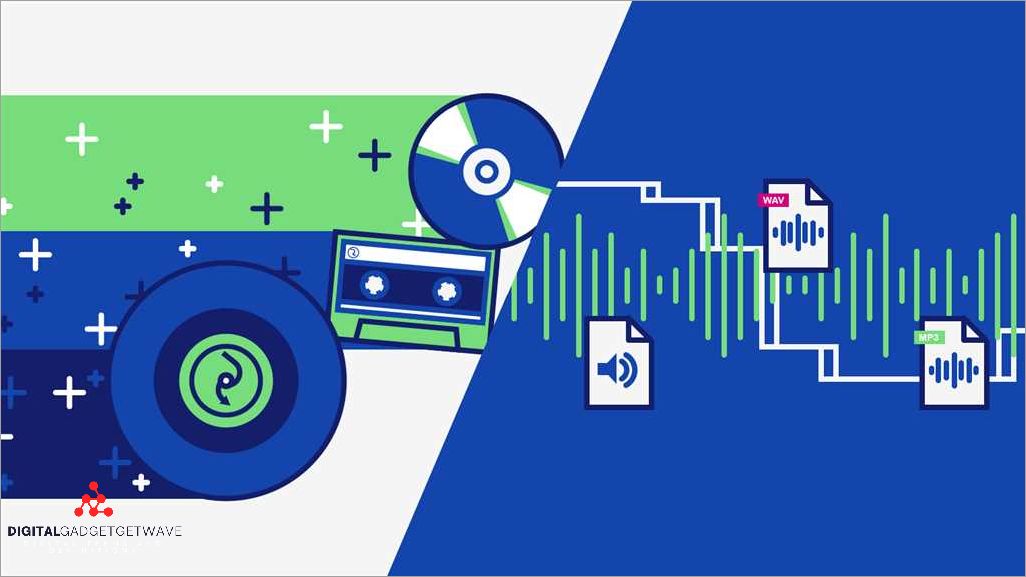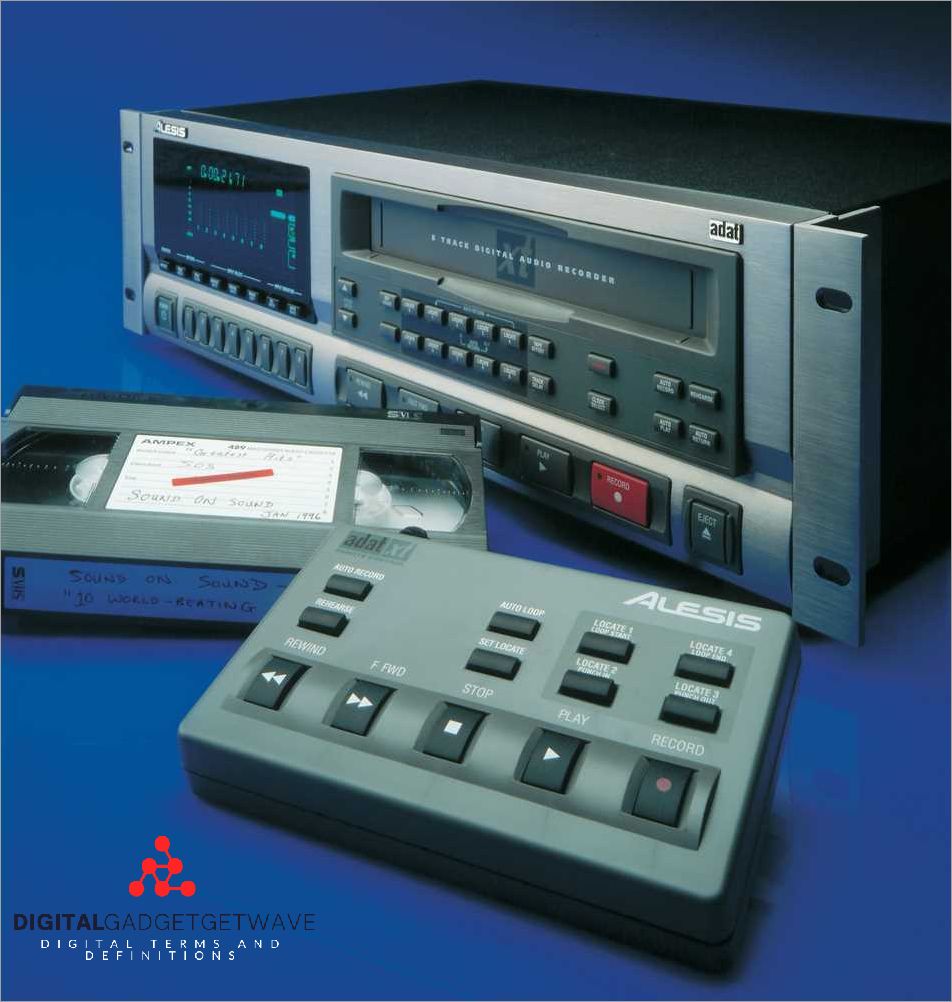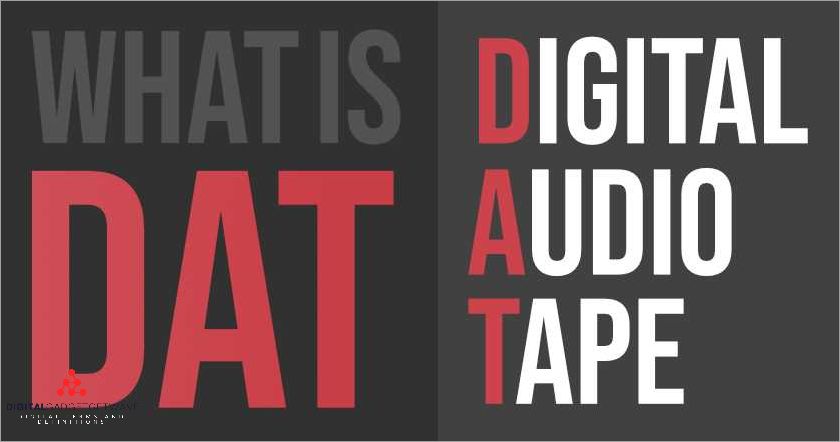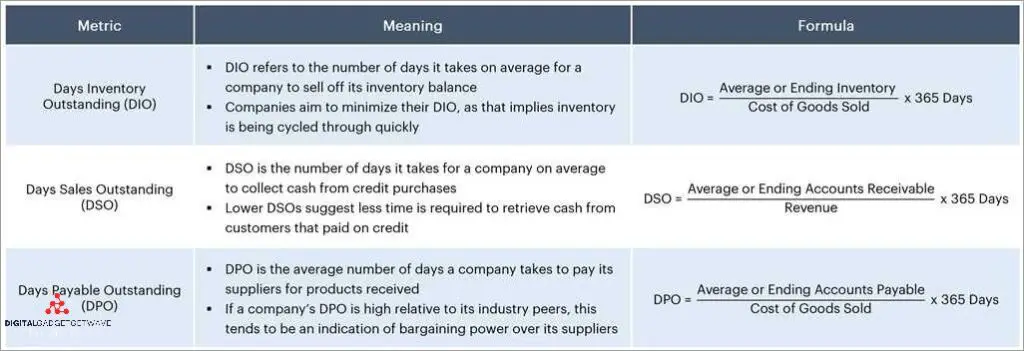
The Digital Audio Tape (DAT) is a digital device that revolutionized the way music and sound recordings were stored and played back. It marked a significant shift from analog to digital technology in the world of audio recording and playback.
Digitalization of data allowed for higher quality audio recordings and improved storage capabilities compared to analog technologies. The DAT recorder used magnetic tape, similar to traditional cassette tapes, but offered a superior format for storing and reproducing sound.
The digital audio tape format offered numerous advantages over analog storage, such as enhanced fidelity and reduced noise. The digital format allowed for more precise and accurate recording and playback of music and other audio content.
The DAT player became popular in the 1990s due to its ability to produce high-quality sound. It quickly gained popularity among audio professionals, musicians, and music enthusiasts, who appreciated its clarity and fidelity of sound reproduction.
With the rise of digital technology, the digital audio tape gradually became obsolete, making way for newer and more efficient forms of audio storage and playback. However, its contribution to the advancement of digital audio cannot be understated, as it played a crucial role in the evolution of audio recording and archiving.
Contents
- 1 What is Digital Audio Tape?
- 2 How Does Digital Audio Tape Work?
- 3 Applications of Digital Audio Tape
- 4 Digital Audio Tape Formats
- 5 FAQ about topic “Digital Audio Tape Definition: Everything You Need to Know”
- 6 What is Digital Audio Tape (DAT)?
- 7 How does Digital Audio Tape work?
- 8 What are the advantages of using Digital Audio Tape?
- 9 Is Digital Audio Tape still in use today?
- 10 Can Digital Audio Tape be used for professional recording?
What is Digital Audio Tape?
Digital Audio Tape, commonly known as DAT, is a digital recording format that was introduced in the mid-1980s as a successor to analog audio tape. It was designed to offer better sound quality and more convenient recording and playback options.
A DAT player is a device that uses digital technology to record and play back music and other audio content. Unlike analog tape recorders, which rely on magnetic tape reels or cassettes, a DAT player uses a digital recording format, allowing for more accurate and precise sound reproduction.
Digital Audio Tape revolutionized the music industry by offering superior sound quality compared to analog tape. It enabled musicians and audio professionals to record and store audio with greater fidelity and clarity. The digitalization of audio allowed for cleaner recordings without the typical hiss and degradation associated with analog tape.
DAT recorders use a magnetic tape that is stored on a reel or cassette. The tape is coated with a magnetic material that stores the audio information in a digital format. This magnetic storage technology ensures reliable playback and long-lasting preservation of the audio content.
One of the key advantages of the DAT format is its compact size. The small cassette form factor made it easy to store and transport, making it popular among musicians, audio engineers, and even consumers. Additionally, DAT players offered features such as fast forward, rewind, and indexing, making it easier to navigate through recordings.
In summary, Digital Audio Tape, or DAT, is a digital recording format that offers high-quality sound and convenient playback options. It combines the advantages of digital technology with magnetic tape storage, resulting in precise and reliable audio recordings.
Advantages of Digital Audio Tape
Digital Audio Tape (DAT) is a magnetic tape technology that revolutionized the audio recording industry. Its primary advantage is its ability to provide high-quality sound with minimal signal loss.
One of the main advantages of DAT is its digital format. Unlike analog reel-to-reel and cassette tape recorders, which convert analog audio signals into magnetic patterns on tape, DAT directly records and stores audio in a digital format. This digitalization process ensures that the recorded audio remains in its pristine quality, without any degradation or loss of information.
DAT players and recorders also offer superior sound quality compared to analog tape devices. The digital audio storage allows for precise reproduction of the original sound, resulting in clearer, more accurate playback. This makes DAT an ideal choice for professional music recording and mastering.
In addition to its high-quality audio performance, DAT offers convenient storage and easy access to recorded data. With the compact cassette-like form factor, DAT tapes can be easily stored and transported. The digital format allows for quick and precise searching of specific tracks, making it effortless to find and navigate through recordings.
DAT technology also provides excellent durability and longevity. The magnetic tape used in DAT is designed to withstand repeated playback and recording, ensuring the longevity of the stored audio. Furthermore, the digital format eliminates the risk of magnetic interference, which can affect the sound quality on analog tapes.
Overall, the advantages of Digital Audio Tape include high-quality sound, digital format, convenient storage, easy access, and durability. These features make DAT an optimal choice for professional audio recording and playback, ensuring that the original audio is captured and reproduced accurately.
History of Digital Audio Tape
Digital Audio Tape (DAT) is a format that revolutionized sound recording and playback. It was introduced in the late 1980s and quickly gained popularity due to its superior sound quality compared to analog formats.
The technology behind DAT involves the use of a digital recorder and tape storage. The recorder uses magnetic heads to convert analog audio signals into digital data, which is then recorded onto the tape. This digitalization of the audio signal ensures higher quality and enables more accurate reproduction of the original sound.
DAT players and recorders became widely used in the professional audio industry, as they offered a compact and efficient way to store and play back digital audio. The tapes used in DAT devices are similar to the reels used in analog tape recorders, but they have a smaller size and can store a larger amount of data.
One of the key advantages of DAT technology is its high storage capacity. DAT tapes can hold up to 4 gigabytes of data, which is equivalent to several hours of high-quality digital audio. This made DAT a popular choice for musicians, recording studios, and audio enthusiasts who wanted to preserve their music in a digital format with minimal loss of quality.
Despite its initial success, the popularity of DAT started to decline in the 1990s with the emergence of new digital audio formats, such as CDs and MP3s. These formats offered more convenience and flexibility, as they allowed for easy distribution and playback of music without the need for physical tapes.
However, DAT still remains an important milestone in the history of digital audio. It paved the way for the development of modern digital recording and storage technologies, and its impact can still be felt in the professional audio industry today.
How Does Digital Audio Tape Work?
Digital Audio Tape (DAT) is a digital magnetic tape format that allows for the recording and storage of high-quality audio. It works by using a digitalization process to convert analog audio signals into digital data that can be stored and played back using a DAT device.
The DAT cassette used in this technology is similar in size to a standard audio cassette but is capable of storing much more data. The tape itself is made up of a thin magnetic strip that allows for the recording and playback of audio signals.
When recording audio on a DAT device, the analog audio signal is converted into a digital format using an analog-to-digital converter. This conversion process involves sampling the audio signal at regular intervals and assigning numerical values to the sampled points.
The digital data is then stored onto the DAT tape using a magnetic recording head. The tape is wound onto a reel inside the cassette, and the head moves along the tape, writing the digital data onto the magnetized surface. This data can be stored and accessed in a linear or helical scan format, depending on the specific DAT recorder or player being used.
When playing back audio from a DAT cassette, the process is reversed. The magnetic head reads the digital data from the tape and sends it through a digital-to-analog converter, which converts the digital data back into an analog audio signal. This analog signal is then amplified and sent to a speaker or headphones, allowing the user to hear the recorded audio.
The use of digital technology in DAT allows for high-quality audio recordings with minimal degradation over time. Unlike analog tape formats, which can suffer from signal loss and degradation over multiple generations of copying, digital audio can be copied and duplicated without any loss of quality.
Overall, the use of digital audio tape technology has revolutionized the recording and storage of audio, providing a more reliable and higher-quality alternative to traditional analog tape formats.
Components of Digital Audio Tape
Digital Audio Tape (DAT) is a magnetic tape technology that is used for recording and storing digital audio data. It consists of several components that work together to ensure high-quality sound recording and playback.
The main component of DAT is the tape itself. The tape used in DAT is similar to the analog tape used in cassette players, but it is designed specifically for digital recording. This tape is coated with a magnetic material that allows it to store digital data in binary form.
Another important component of DAT is the tape reel. The tape reel is the device that holds the tape and allows it to be fed through the tape player. It ensures that the tape is properly aligned and allows for smooth and accurate playback.
The tape player is the device that reads the information stored on the tape. It uses a set of sensors to detect the magnetic signals on the tape and convert them into digital data. The tape player also includes a digital-to-analog converter, which converts the digital data back into analog audio signals for playback.
Digital Audio Tape technology also includes various recording formats and data compression techniques that enhance the quality and storage capacity of the tapes. These formats and techniques allow for more precise digitalization of music and ensure that the recorded sound is faithful to the original audio source.
Overall, the components of Digital Audio Tape work together to provide a high-quality and reliable digital audio recording and playback experience. They enable the storage and playback of digital audio data in a compact and portable format, making it an essential technology for professionals and music enthusiasts alike.
Recording and Playback Process

Recording and playback process on a Digital Audio Tape (DAT) involves several steps that ensure high-quality digital audio storage and playback.
The recording process starts with the selection of the desired audio source, such as a musical instrument or a microphone. The analog sound waves produced by the source are then converted into digital data using the device’s analog-to-digital converter. This conversion process is crucial for preserving the quality of the audio signal.
Once the analog sound is converted into digital data, it is recorded onto the magnetic tape in a digital format. The digitalization of the sound wave allows for better storage and reproduction of the audio, as it eliminates the degradation and noise associated with analog tape recording.
To ensure accurate recording and playback, the digital audio tape uses a helical scanning technology. This technology allows the tape to be read and written in a diagonal pattern, increasing the data density and improving the overall playback quality.
During playback, the digital data is retrieved from the tape and converted back into analog sound waves using the digital-to-analog converter. This conversion process allows the stored audio to be played back through speakers or headphones, recreating the original music or sound.
The digital audio tape provides efficient and reliable storage for audio data, with the capacity to store up to 2 hours of high-fidelity sound on a single reel. Its compact size and superior playback quality made it a popular choice for professional audio recording and broadcasting in the 1990s.
In summary, the recording and playback process of a Digital Audio Tape involves converting analog sound into digital data, recording it onto magnetic tape using digital technology, and then retrieving and converting the digital data back into analog sound for playback.
Comparison with Analog Tape
Analog tape uses a reel-to-reel format, where a magnetic tape is wound on a reel and played back using a tape player. This technology has been widely used for music and audio recording and playback for many decades.
Digital tape, on the other hand, uses a different format and technology. Instead of storing sound information on a physical magnetic tape, digitalization converts the audio into data that can be stored on a digital device, such as a computer or a hard drive.
Digital audio tape offers several advantages over analog tape. Firstly, the sound quality of digital recordings is generally higher. The digital format allows for more accurate and precise recording, resulting in a clearer and more detailed sound reproduction.
In addition, digital tape offers better durability and longevity compared to analog tape. Magnetic tapes used in analog recording can degrade over time, resulting in a loss of sound quality. Digital recordings, however, can be stored on various digital storage devices, such as hard drives or cloud storage, allowing for easy backup and preservation.
Furthermore, digital tape provides greater convenience and versatility. Unlike analog tape, which requires specific tape players for playback, digital recordings can be played back on a wide range of devices, including computers, smartphones, and portable music players.
In conclusion, while analog tape has been the go-to technology for music and audio recording for many years, digital tape presents several advantages in terms of sound quality, durability, and convenience. The transition from analog to digital has revolutionized the way we record and store audio, offering improved capabilities and flexibility for both professionals and casual users.
Applications of Digital Audio Tape
Digital Audio Tape (DAT) format revolutionized the recording industry with its high-quality audio recordings and reliable digital technology. Here are some of the key applications of Digital Audio Tape:
- Studio Recording: Digital Audio Tape became popular in recording studios due to its ability to capture audio in a high-quality digital format. It offered superior sound clarity and allowed for easy editing and post-production work.
- Music Production: Many musicians and music producers embraced DAT for its precise and accurate reproduction of sound. The format allowed for the creation of high-quality music recordings, which could be easily transferred to other digital devices or formats.
- Archiving and Storage: Digital Audio Tape was widely used for archiving purposes due to its large storage capacity and long-term durability. Its magnetic tape-based technology ensured that audio data could be reliably stored for extended periods without any loss in quality.
- Broadcasting: Radio stations and broadcasting companies also relied on DAT for recording and editing audio content. The format offered a convenient and efficient way to capture and manipulate sound, making it ideal for broadcasting purposes.
- Audio Preservation: Digital Audio Tape played a crucial role in preserving analog audio recordings. Its digitalization capabilities allowed for converting analog sound into a digital format, ensuring that valuable music and historical recordings could be stored for future generations.
In conclusion, Digital Audio Tape had a significant impact on the music and recording industry, offering high-quality audio recordings, convenient storage, and digitalization capabilities. Its reliable and efficient technology made it an essential device for studios, musicians, broadcasters, and archivists.
Studio Recording and Mastering

In the digital age, technology has revolutionized the way music is recorded and mastered in studios. Advancements in digital audio recording have significantly improved the sound quality and efficiency of the recording process. Instead of using analog cassette tapes, which were prone to degradation and had limited storage capacity, studios now utilize digital recording devices.
Digital audio recorders, such as magnetic tape recorders and hard disk recorders, offer superior sound quality and allow for easy manipulation of the recorded tracks. With digital technology, it is possible to capture every detail of a musical performance, resulting in a more faithful representation of the original sound.
Furthermore, digital recording allows for easy editing and mixing of tracks, enabling producers and engineers to enhance the sound and create a polished final product. The flexibility of digitalization also makes it possible to store and transfer the recorded data in various formats, ensuring compatibility with different playback devices and platforms.
Studio recording and mastering involve the use of advanced equipment and techniques to achieve optimal sound quality. Professional studios often use high-quality microphones, preamplifiers, and digital interfaces to capture and process the music. The recorded tracks are then mixed and balanced to create a cohesive sound.
In the mastering phase, the audio is further refined to ensure consistent playback across various devices and platforms. This involves adjusting the overall volume, equalization, and compression to achieve a balanced and dynamic sound. Mastering engineers have a critical role in ensuring that the final product meets the highest standards of audio quality.
Overall, studio recording and mastering have greatly benefited from digital technology, providing musicians and producers with powerful tools to capture, manipulate, and enhance their music. The advent of digital audio has revolutionized the music industry, offering endless possibilities for creativity and pushing the boundaries of sound.
Broadcast and Radio Industry
The broadcast and radio industry has undergone significant changes over the years with the advent of digitalization. The traditional analog recording and playback devices have been replaced by digital formats, resulting in improved sound quality and efficient storage options.
One of the most important advancements in the industry is the introduction of digital audio tape (DAT) players. DAT players utilize magnetic tape technology to record and store digital audio data. These devices revolutionized the way music and audio recordings were produced and consumed.
Digital audio tapes are small cassettes that utilize a magnetic tape to store and playback sound in a digital format. The recordings made on a digital audio tape are of high quality and can be easily transferred to a computer or other digital storage devices for further editing or distribution.
Digital audio tape recorders have become an integral part of the broadcast and radio industry as they allow for precise and accurate recording of audio. These devices are widely used for professional music recording, radio broadcasting, and audio production.
The digital audio tape format offers several advantages over analog recording technologies. It allows for longer recording times, improved audio quality, and easy editing capabilities. Additionally, the compact size of the digital audio tapes makes them convenient for transportation and storage.
In conclusion, the broadcast and radio industry has embraced digital audio tape technology as a reliable and efficient means of recording and storing audio data. The introduction of DAT players has revolutionized the industry, providing professionals with high-quality sound recordings and versatile storage options.
Archiving and Preservation
Archiving and preservation of audio recordings have always been a matter of concern due to the degradation of analog formats over time. Digital Audio Tape (DAT) format emerged as a reliable solution to this problem. With DAT, reel-to-reel tape recorders were replaced by digital devices capable of capturing and storing high-quality sound.
Digitalization played a crucial role in archiving and preserving audio recordings. The digital format offered a more efficient and reliable way to store and reproduce music, speech, and other types of audio data. DAT technology allowed for the creation of digital audio archives, ensuring that recordings would remain intact for a longer period of time.
One of the advantages of DAT technology is its ability to maintain the quality of the original analog recording. By converting analog signals into digital data and recording them on tape, DAT preserved the audio fidelity and prevented any loss or degradation of sound. This ensured that the preserved recordings would sound just as good as the original ones when played back on a DAT player.
DAT tapes were also an ideal medium for long-term storage of audio recordings. The compact size and portability of DAT cassettes made it easy to store and organize a large number of recordings. Additionally, the durability of DAT tapes ensured that the audio data remained intact and usable for an extended period of time.
In conclusion, Digital Audio Tape (DAT) format revolutionized the archiving and preservation of audio recordings. Its digital technology and high-quality sound reproduction capabilities made it a reliable and efficient medium for storing and preserving music, speech, and other types of audio data, while ensuring the longevity and fidelity of the recordings.
Digital Audio Tape Formats
In the world of audio recording and music storage, digital audio tape (DAT) has played a significant role. DAT is a magnetic tape format that allows for high-quality digital recordings. With its advanced technology, DAT provides a more accurate and precise reproduction of sound compared to analog cassette tapes.
DAT tapes are small and compact, utilizing reels for storage. The format offers a versatile recording medium, making it suitable for various applications, such as professional music production, mastering, and archival purposes.
DAT recorders and players use digitalization to convert analog sound signals into digital data. This conversion process ensures the preservation of sound quality and eliminates the limitations of analog technology, such as tape hiss and degradation over time.
DAT tapes typically have a capacity of about 2 to 4 gigabytes, allowing for several hours of recording time. The format provides high fidelity and accuracy, making it a preferred choice for professional musicians, audio engineers, and enthusiasts who require superior sound quality.
While DAT tapes are no longer widely used in consumer electronics, they still hold value in certain industries. The format’s ability to store large amounts of high-quality digital audio data makes it useful for audio archiving and for organizations that require long-term storage of audio recordings.
In summary, digital audio tape formats offer a reliable and efficient means of recording and storing sound in a digital format. The format’s magnetic reel technology combined with digitalization ensures high fidelity and accurate reproduction of music and sound recordings. While no longer widely used, DAT tapes continue to serve specific industries’ needs for superior audio quality and long-term storage.
Comparison of DAT Formats

Digital Audio Tape (DAT) formats revolutionized the music industry by introducing high-quality digital recording and storage technology.
DAT devices utilize magnetic tape as the storage medium for recording audio. Unlike analog cassette tapes, DAT formats enable the digitalization of sound, resulting in enhanced audio quality and durability.
One of the major differences between DAT formats is the reel size. Standard reel DAT recorders use 4mm tapes, while larger reel DAT recorders use 8mm tapes. The choice of 4mm or 8mm reel size depends on the requirements of the specific recording project.
Furthermore, DAT formats also differ in terms of the tape length they can accommodate. Some DAT formats can handle tapes with a length of up to 120 minutes, while others can only handle tapes with a maximum length of 60 minutes. The choice of tape length depends on the desired recording duration.
Another important aspect to consider when comparing DAT formats is the recording speed. Different DAT formats support different recording speeds, ranging from standard speed (SP) to high speed (HS) formats. Higher recording speeds generally result in improved audio quality, but also require more storage space on the tape.
In summary, DAT formats offer a digital alternative to analog cassette tapes, providing higher audio quality and storage capacity. When choosing a DAT format, factors such as reel size, tape length, and recording speed should be taken into account to ensure compatibility and desired audio results.
Future of Digital Audio Tape
The future of digital audio tape (DAT) looks promising as advancements in technology continue to improve its capabilities. Digital audio tape is a format that allows for the storage and recording of high-quality audio data in a digital format. With the increasing digitalization of the music industry, digital audio tape has the potential to revolutionize the way we consume and create music.
Unlike analog reel-to-reel tape recorders, digital audio tape offers numerous advantages in terms of sound quality and storage capacity. By converting audio signals into digital data, digital audio tape eliminates the hiss and distortion commonly associated with analog recordings. This ensures that the recorded sound is clean and accurate, preserving the original quality of the audio.
In addition to its superior sound quality, digital audio tape also offers convenient storage and playback options. The compact size of a DAT tape allows for easy transportation and storage, making it a practical choice for musicians and recording studios. Furthermore, digital audio tape players and devices are widely available, making it easy to access and play back recordings.
The future of digital audio tape lies not only in its use for music recording, but also in its application for other data storage purposes. The magnetic tape used in DAT technology has the potential to store large amounts of data, making it suitable for archiving and data backup. This versatility opens up opportunities for digital audio tape to be used in various industries, including broadcasting, film, and gaming.
Overall, the future of digital audio tape looks promising. Its high-quality sound, convenient storage options, and potential for data recording make it a valuable technology in the digital age. As advancements in technology continue to evolve, we can expect digital audio tape to play a significant role in the way we record, store, and consume audio in the future.
FAQ about topic “Digital Audio Tape Definition: Everything You Need to Know”
What is Digital Audio Tape (DAT)?
Digital Audio Tape (DAT) is a magnetic tape format that was developed in the 1980s for recording and playback of high-quality digital audio. It uses a rotating head to read and write data onto the tape, similar to a cassette tape.
How does Digital Audio Tape work?
Digital Audio Tape works by converting analog audio signals into digital data. The digital data is then recorded onto the tape using a rotating head mechanism. When played back, the digital data is converted back into analog audio signals for playback.
What are the advantages of using Digital Audio Tape?
Using Digital Audio Tape has several advantages. Firstly, it offers superior sound quality compared to other analog tape formats. It also allows for easy editing and manipulation of audio recordings. Additionally, Digital Audio Tape offers excellent storage and preservation of audio due to its durable tape medium.
Is Digital Audio Tape still in use today?
While Digital Audio Tape was popular in the 1980s and 1990s, it is no longer commonly used today. Advancements in digital audio technology and the rise of other digital storage formats, such as CDs and digital streaming, have made Digital Audio Tape obsolete for most purposes.
Can Digital Audio Tape be used for professional recording?
Yes, Digital Audio Tape can be used for professional recording purposes. Its high-quality sound and ability to handle multiple tracks make it suitable for professional audio production. However, due to its limited availability and outdated technology, many professionals have switched to more modern digital recording methods.

